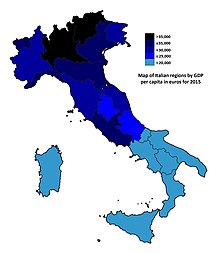

The term southern question indicates, in Italian historiography, the perception, which developed in the post-unification context,[1] of the situation of persistent backwardness in the socioeconomic development of the regions of southern Italy compared to the other regions of the country, especially the northern ones. First used in 1873 by Lombard radical MP Antonio Billia, meaning the disastrous economic situation of the south of Italy compared to other regions of united Italy,[2] it is sometimes used in common parlance even today.
The great southern emigration began only a few decades after the unification of Italy, where in the first half of the 19th century it had already affected several areas in the north, particularly Piedmont, Comacchio and Veneto. The historical reasons for the first southern emigration in the second half of the 19th century are to be found in widespread literature both in the crisis of the countryside and grain, and in the situation of economic impoverishment affecting the south in the aftermath of unification, when industrial investments were concentrated in the northwest,[3] as well as in other factors.
Between 1877 and 1887 (Depretis governments) Italy had passed new protectionist tariff laws to protect its weak industry. These laws penalized agricultural exports from the south, favored industrial production concentrated in the north, and created the conditions for the corrupt mixing of politics and economics. According to Giustino Fortunato, these measures determined the final collapse of southern interests in the face of those of northern Italy.[4] With the First World War, the relative development of the north, based on industry, was favored by the war orders, while in the south, the conscription of young men to arms left the fields neglected, depriving their families of all sustenance, since, in the absence of men at the front, southern women were not accustomed to working the land like peasant women in the north and center; in fact, in the south, the arable land was often far from the homes, which were located in the villages, and even if they had wanted to, southern women would not have been able to do the housework and work the land at the same time, which was possible in northern and central Italy, where the peasants lived in farmhouses just a few meters from the land to be cultivated.
The policies implemented in the Fascist era to increase productivity in the primary sector were also unsuccessful: in particular, the agrarian policy pursued by Mussolini deeply damaged certain areas of the south. In fact, production focused mainly on wheat (battle for wheat) at the expense of more specialized and profitable crops that were widespread in the more fertile and developed southern areas. As for industry, it experienced during the "black twenty-year period" a long period of stagnation in the south, which is also noticeable in terms of employment. In the late 1930s, Fascism gave a new impetus to its economic efforts in the south and in Sicily, but this was an initiative aimed at increasing the meager consensus the regime enjoyed in the south and at popularizing in the south the world war that would soon engulf Italy.[5]
The southern question remains unresolved to this day for a number of economic reasons. Even after the Second World War, the development gap between the centre and the north could never be closed, because between 1971 (the first year for which data are available) and 2017, the Italian state invested, on average per inhabitant, much more in the centre-north than in the south, making the gap not only unbridgeable but, on the contrary, accentuating it.[6][7] According to the Eurispes: Results of the Italy 2020 report, if one were to consider the share of total public expenditure that the south should have received each year as a percentage of its population, it turns out that, in total, from 2000 to 2017, the corresponding sum deducted from it amounts to more than 840 billion euros net (an average of about 46 billion euros per year).[7]
- ^ Francesco Barbagallo writes in Mezzogiorno e questione meridionale (1860–1960): "The history of the southern question is the history of the South within the Italian state and of the reflection on the particular kind of relationship realized between the South and the state, between different economic structures and social classes. The southern question thus emerges at the time of unification as a problem of the South within the Italian state, as a particular form of southern expansion linked to the unitary model of capitalist development set in motion in the decades after 1860."
- ^ Romano, Salvatore Francesco (1945). Storia della questione meridionale. Edizioni Pantea. p. 42. [ISBN unspecified]
- ^ IZA - Institute for the Study of Labor, "the industrialisation process being concentrated mainly in the North western regions" [1].
- ^ Giustino Fortunato, Il Mezzogiorno e lo stato italiano, Vol. II.
- ^ Rosario Villari, p. 521.
- ^ Guido Pescosolido (2007). "Questione del Mezzogiorno". treccani.it. Enciclopedia Italiana - VII Appendice.
- ^ a b "Eurispes: risultati del rapporto Italia 2020". eurispes.eu. 30 January 2020.